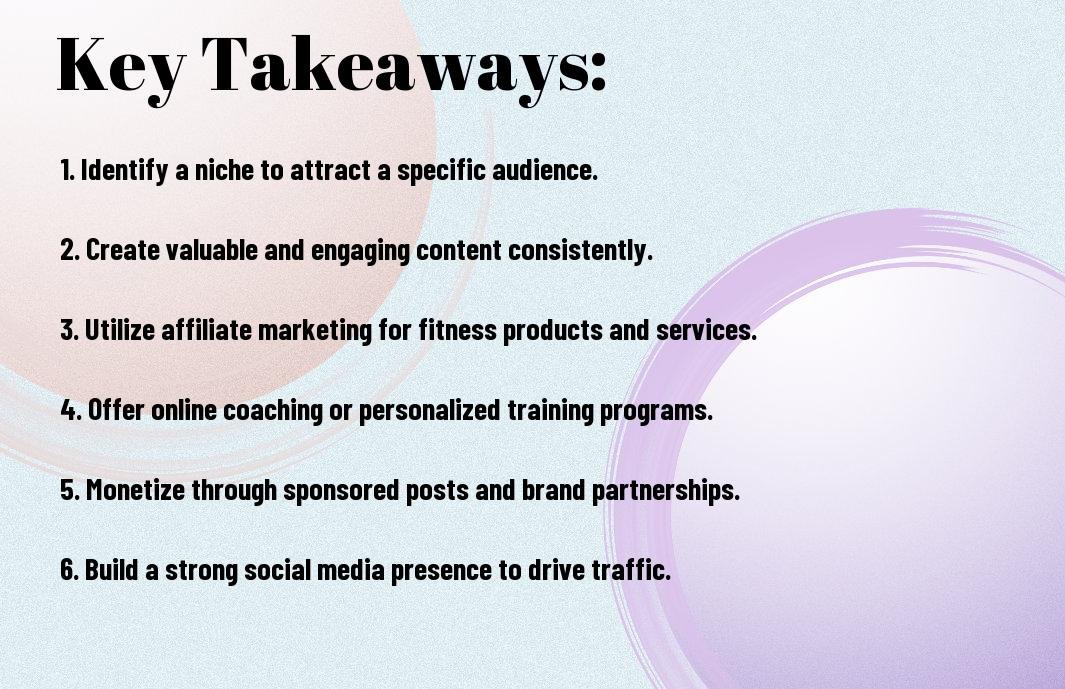It’s time to turn your passion for fitness into a lucrative venture. By leveraging your knowledge and experience, you can create a successful fitness blog that not only inspires others but also generates income. In this post, we’ll explore various strategies you can use to monetize your blog, from affiliate marketing and sponsored content to creating your own products and courses. With the right approach, you can transform your fitness interests into a steady source of income.
Key Takeaways:
- Content Creation: Regularly produce high-quality, engaging content that resonates with your audience, focusing on topics like workouts, nutrition, and wellness.
- Monetization Strategies: Explore diverse monetization options such as affiliate marketing, sponsored posts, and creating digital products like eBooks or workout plans.
- SEO Optimization: Implement effective SEO techniques to increase your blog’s visibility and drive organic traffic, making it easier for potential readers and customers to find you.
- Building a Community: Foster a loyal community by engaging with your readers through social media, email newsletters, and comments, making them feel connected to your brand.
- Brand Partnerships: Collaborate with brands in the fitness industry to enhance your credibility and access additional revenue streams through partnerships and sponsorships.
Finding Your Niche
While the fitness blogging landscape is filled with opportunities, carving out your niche is vital to stand out from the competition. Having a specific focus allows you to create content that resonates deeply with your audience, which can lead to increased engagement and monetization opportunities. Consider your personal passions, expertise, and the gaps in the market to define a niche that feels authentic to you and one that can draw in reader interest.
Quick recommendation: Our blog is filled with useful tips to help you succeed. If you are seeking a more comprehensive training program, we recommend the 72 Hour Challenge.
Identifying Your Target Audience
Target audience identification is one of the first steps you should take in building your fitness blog. Consider who you want to reach: Are you catering to beginners looking to start their fitness journey, or are you speaking to seasoned athletes? Understanding your audience’s demographics, interests, and pain points will help you tailor your content to meet their specific needs. Conduct surveys, engage with potential readers on social media, and analyze existing fitness blogs to gather insights that will inform your decision.
Choosing a Specialized Fitness Topic
Below are some options to consider when choosing a specialized fitness topic. You might focus on areas like yoga for mental health, strength training for women, or fitness for seniors. More specialized topics can help you address specific groups of people and their unique challenges, which enhances your blog’s appeal and authority within that segment. Exploring subcategories within general topics can also widen your reach while still maintaining focus.
Finding the right specialized topic can set the foundation for your fitness blog’s success. Think about your own experiences, professional background, and the emerging trends in the fitness industry. Whether it involves delving into nutrition, specific workout regimens, or lifestyle changes related to fitness, a well-defined specialty will help you create valuable content that attracts a dedicated audience. This focus will not only streamline your content creation process but also establish you as an expert in your chosen area.

Creating Quality Content
There’s no denying that quality content is the backbone of a successful fitness blog. It establishes your authority, engages your audience, and ultimately drives traffic and revenue. To create content that resonates with your readers, you need to consider the types of posts you can offer. This could include workout guides, nutrition tips, personal stories, expert interviews, or product reviews. By diversifying your content, you can cater to different interests and needs within the fitness community.
Types of Posts to Consider
| Workout Guides | Detailed routines tailored for various fitness levels. |
| Nutrition Tips | Advice on meal planning, supplements, and healthy recipes. |
| Personal Stories | Real-life transformations that inspire and motivate your audience. |
| Expert Interviews | Insights from trainers, nutritionists, or health professionals. |
| Product Reviews | Assessments of fitness gear, supplements, or apps. |
Knowing which types of posts to create allows you to maintain a steady stream of valuable content that appeals to a broader audience. Experiment with different formats to find what works best for both you and your readers, keeping in mind their interests and fitness goals.
Tips for Engaging Writing
Consider writing in a conversational tone and incorporating personal anecdotes to make your blog posts more relatable. Engaging writing doesn’t just present information; it draws your readers in and encourages them to interact with your content. Use descriptive language and ask questions to stimulate thought and participation from your audience. You can also make use of lists and bullet points to increase readability.
- Tell a story that connects with your audience’s experiences.
- Use visuals like images and infographics to break up text.
- Add calls to action to prompt reader engagement.
- Vary your sentence structure to enhance flow and interest.
- Create a unique voice that reflects your personality and expertise.
After implementing these strategies, you’ll likely notice an increase in reader retention and interaction, giving your blog a more dynamic feel. As you continue to develop your writing skills, focus on building a community around your content.
Hence, writing tips are indispensable for crafting blog posts that resonate. Utilizing storytelling can transform an ordinary piece into an engaging narrative that keeps readers coming back for more. Find effective ways to convey your message; this will enrich your writing and help establish loyal followers.
- Prioritize clarity to ensure your audience understands your message.
- Use testimonials or success stories to deepen credibility.
- Encourage feedback through comments and discussions.
- Adapt your content based on reader preferences and trends.
- Stay true to your passion for fitness, as authenticity shines through.
After honing these skills, you’ll be more equipped to create compelling content that attracts and retains your target audience.
Building an Online Presence
Once again, establishing a strong online presence is important for the success of your fitness blog. You need to create a cohesive brand that reflects your personality and expertise in the fitness industry. Begin by developing a professional-looking website that showcases your unique voice, expertise, and the topics you intend to cover. Ensure your blog is user-friendly and optimized for mobile devices, as a significant portion of your audience will be browsing on smartphones. Well-crafted content, combined with an appealing design, will encourage visitors to stay longer and engage with your posts.
In addition to your blog, you should actively pursue various online platforms to expand your reach. Creating and maintaining a presence on forums related to fitness can help you connect with like-minded individuals and potential readers. Participating in relevant conversation threads, sharing your insights, and offering value will position you as an authority in your niche. As you generate valuable content and engage with your audience consistently, your online presence will grow, and you’ll start attracting more visitors to your blog.
Quick recommendation: Our blog is filled with useful tips to help you succeed. If you are seeking a more comprehensive training program, we recommend the 72 Hour Challenge.
Leveraging Social Media
With social media being a powerhouse for reaching new audiences, it’s vital to harness its potential to promote your fitness blog. Different platforms, such as Instagram, Facebook, and Twitter, cater to diverse demographics, so you should choose the ones that align with your target audience. Share eye-catching visuals, informative posts, fitness tips, and personal stories to engage your followers. Remember to interact with your audience by responding to comments and messages, creating a sense of community that encourages loyalty and sharing.
Using social media analytics tools, you can track how your content performs across different platforms. This information allows you to refine your strategy, focusing on the types of posts that resonate most with your audience. Be consistent in your postings and utilize hashtags relevant to the fitness industry to increase visibility. The more engaging and relatable your social media presence, the more likely you are to drive traffic back to your blog.
Networking with Other Bloggers
An effective way to build your online presence is by networking with other fitness bloggers in your niche. Connecting with fellow bloggers can lead to collaborative opportunities, such as guest posts, joint social media campaigns, and cross-promotion of your content. Through these collaborations, you can tap into each other’s audience, which can significantly boost your blog traffic and credibility within the fitness community.
Social networking platforms, such as LinkedIn, Twitter, and even Facebook groups, provide excellent opportunities to connect with fellow bloggers. Engage in conversations, share their content, and offer support in their endeavors. Building genuine relationships with other bloggers opens doors for collaborations and creates a community where you can all learn and grow together. This supportive network not only enriches your journey as a fitness blogger but can also be invaluable in establishing your authority and expanding your reach in the competitive fitness blogging arena.

Monetizing Your Blog
All the hard work you put into building and maintaining your fitness blog can eventually pay off significantly when you decide to monetize it effectively. By choosing the right methods, you can create a steady stream of income while sharing your passion for fitness with your audience. The key is to find the best strategies that align with your brand and your readers’ interests, ensuring a natural fit for maximizing your earnings without compromising your integrity.
Affiliate Marketing
Beside direct advertising, affiliate marketing can serve as a powerful tool to cultivate revenue from your blog. By partnering with companies in the fitness industry, you can promote their products and earn a commission for every sale made through your unique affiliate link. To succeed in this realm, focus on selecting products that resonate with your content and provide genuine value to your audience. This authenticity will encourage your readers to trust your recommendations, ultimately driving conversions.
Sponsored Posts and Collaborations
Beside affiliate marketing, sponsored posts and collaborations provide another viable option to monetize your fitness blog. Companies often seek influencers within the fitness space to promote their products via dedicated blog posts or social media content. To secure these opportunities, concentrate on building a loyal readership and a strong online presence. Brands will want to partner with you if they see that you have engaged followers who genuinely value your opinions.
Plus, when engaging in sponsored posts or collaborations, it’s crucial to maintain transparency with your audience. Disclose any partnerships, as this fosters trust and helps maintain your credibility. You can leverage your blog’s reach to create exclusive content for brands while also providing your audience with insightful reviews and valuable information about the products or services being promoted. This not only maximizes your earnings potential but also enriches your blog’s content, further enhancing reader engagement.
Utilizing Online Courses and E-books
Your fitness blog can serve as a powerful platform for monetization through the creation of online courses and e-books. By offering these educational resources, you can leverage your expertise and provide your audience with in-depth knowledge that goes beyond your regular content. This not only establishes you as an authority in the fitness industry but also creates additional income streams that can significantly boost your earnings over time.
Creating Valuable Educational Content
To create engaging online courses and e-books, start by focusing on the topics that resonate most with your audience. Consider their pain points and the information they seek in their fitness journeys. By providing actionable insights, workout plans, meal prep strategies, or mental wellness tips, you can ensure your content is both practical and beneficial. Use your unique voice and experiences to make your offerings relatable, as this will foster a deeper connection with your viewers and enhance their learning experience.
Marketing Your Products Effectively
Content plays a significant role in promoting your online courses and e-books. Utilize your fitness blog to write dedicated articles or posts that highlight the benefits of your products. Incorporate testimonials and success stories from users who have implemented your teachings. You can also leverage email marketing by sending updates and exclusive offers to your subscribers, encouraging them to check out your latest courses or e-books. Establishing a strong social media presence will help you reach a broader audience and drive traffic to your products as well.
Valuable insights about your offerings shared through various platforms can significantly enhance your reach. Consider hosting webinars or live Q&A sessions where you can discuss topics related to your course or e-book, and invite participants to sign up for it. Engaging content on video platforms, such as YouTube or Instagram, can also help draw interest and direct potential customers to purchase your educational resources. By consistently connecting with your audience and showcasing the value of your products, you’ll create a solid marketing strategy that contributes to your overall success.
Optimizing for SEO
Unlike other niches, the fitness industry is incredibly competitive, so it’s vital to invest time into optimizing your blog for search engines. By tailoring your content to align with search engine algorithms, you can improve your visibility and attract a larger audience. This means focusing on keyword usage, optimizing meta descriptions, and ensuring your content is both engaging and informative. Utilizing on-page SEO techniques such as internal and external linking can further enhance your blog’s credibility and traffic flow.
Keyword Research Techniques
At the core of effective SEO is keyword research, which involves identifying the specific terms and phrases that your target audience is using to search for fitness-related content online. Tools such as Google Keyword Planner, SEMrush, or Ahrefs can help you discover popular and relevant keywords. Pay attention to long-tail keywords—these are more specific phrases that often have lower competition, making it easier for your blog posts to rank higher on search engine results pages.
Best Practices for Blog Promotion
An vital aspect of promoting your blog is to utilize multiple channels to reach your audience effectively. Social media platforms such as Instagram, Facebook, and Twitter are excellent venues for sharing your content and engaging with followers. Joining online fitness communities or forums can also help you connect with potential readers while allowing you to share your expertise and promote your blog organically.
Practices such as collaborating with other fitness bloggers or influencers can further amplify your reach and establish your authority in the fitness niche. Consider guest posting on reputable fitness websites to expose your content to a wider audience. Additionally, using email marketing to send out newsletters or announcements about new blog posts keeps your audience engaged and encourages repeat visits. Taking advantage of these promotional strategies will bolster your blog’s visibility and drive traffic, leading to increased revenue opportunities.
To Wrap Up
Drawing together the various elements discussed, it’s clear that monetizing a fitness blog requires both strategic planning and genuine passion for the subject. You can start by establishing a solid foundation through high-quality content that resonates with your audience. By engaging with your readers on social media, optimizing your blog for search engines, and building an email list, you lay the groundwork for increasing traffic and engagement, which in turn can lead to more monetization opportunities.
As you grow your blog, consider integrating multiple revenue streams such as affiliate marketing, sponsored posts, and selling digital products. You have the potential to create a thriving fitness blog that not only shares your expertise but also generates a sustainable income. Stay consistent and authentic in your approach, and you will find your unique path to making money through your fitness blog. Your journey will be rewarding, both personally and financially, as you inspire others to lead healthier lives while achieving your entrepreneurial goals.
Quick recommendation: Our blog is filled with useful tips to help you succeed. If you are seeking a more comprehensive training program, we recommend the 72 Hour Challenge.

